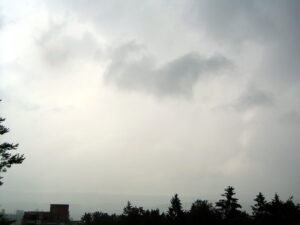In Latin: Undulatus Asperitas
These cloud formations were first popularized and proposed as a distinct type by Gavin Pretor-Pinney of the Cloud Appreciation Society back in 2009. They were later added to the International Cloud Atlas in 2017, marking the first new cloud type since cirrus intortus in 1951. Asperitas clouds often appear dark and storm-like, yet they usually dissipate without an actual storm forming. So, while they might look ominous, they’re more like the sky’s moody artwork than a harbinger of bad weather.
1. What Are Asperitas Clouds?
- Asperitas clouds are a distinctive, but relatively rare cloud formation. They take the appearance of rippling waves or undulating folds in the sky.
- Imagine looking up and seeing the roughened surface of a stormy sea mirrored in the clouds above. It’s like the sky practising its abstract painting skills! 🎨
2. Characteristics:
- Asperitas clouds are localized waves in the cloud base. They can be smooth or dappled with smaller features, sometimes descending into sharp points.
- Varying levels of illumination and thickness of the cloud can lead to dramatic visual effects. Picture a cosmic canvas with texture and movement.
3. Height of Base:
- Asperitas clouds typically form between 4,000 and 10,000 feet above the ground. They thrive in the middle and upper levels of the atmosphere.
- When you spot them, it’s like the sky saying, “Hey, check out my wavy masterpiece!” 🌤️🌊
4. Weather Associations:
- While the formation itself does not produce rainfall, asperitas clouds have been linked to thunderstorms, occurring afterwards.
- The unstable atmospheric conditions required for the wavy cloud base could also allow the growth of convective rain clouds, meaning that Asperitas could be accompanied by other precipitation-producing clouds.
5. The ‘Newest’ Cloud Type:
- Asperitas was officially added to the World Meteorological Organisation’s International Cloud Atlas in 2017. It’s the first new cloud type recognized in over 50 years!
- Between its mysterious appearance and UFO-like vibes, asperitas keeps the sky’s secrets well-guarded. 👽
The MetOffice has a page on these clouds
Tell us how can we improve this post?
Hi I am Marcus, MM0ZIF, a licenced Radio Amateur, Doctor of Musicology, amateur weather enthusiast. I over the years have been a Amateur Radio Tutor, Examiner, and a Regional Manager for the Radio Society of Great Britain.
This site is dedicated more towards Amateur Radio and Weather, with an angle on Technology too. I also maintain https://havenswell.com/ which is my other blog which is more aimed at cooking, hobbies and life in general as well as businness and networking.










